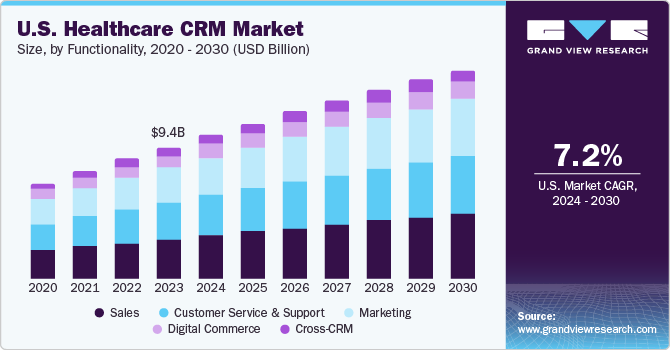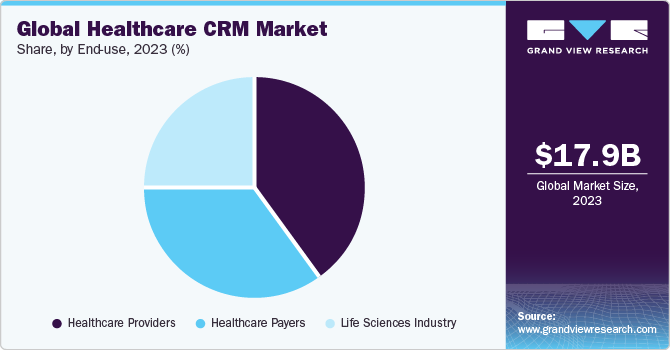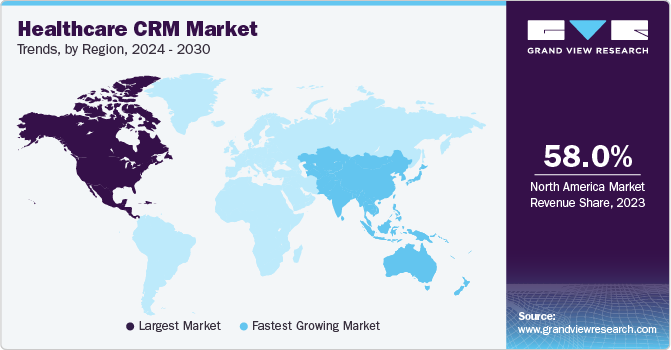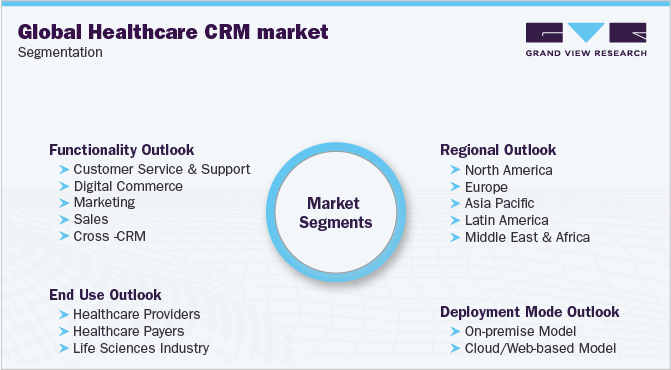- Home
- »
- Healthcare IT
- »
-
Global Healthcare CRM Market Size Report, 2022 - 2030GVR Report cover
![Healthcare CRM Market Size, Share & Trends Report]()
Healthcare CRM Market Size, Share & Trends Analysis Report By Functionality, By Deployment Mode (On-premise Model, Cloud/Web-based Model), By End-use, By Region, And Segment Forecasts, 2022 - 2030
- Report ID: GVR-1-68038-204-4
- Number of Pages: 150
- Format: Electronic (PDF)
- Historical Range: 2017 - 2021
- Industry: Healthcare
Report Overview
The Healthcare CRM market size was valued at USD 14.3 billion in 2021 and is estimated to grow at a compound annual growth rate (CAGR) of 8.4% from 2022 to 2030. Increasing demand for structured data and automation in a healthcare organization is projected to drive market growth. The demand for healthcare-based Customer Relationship Management (CRM) is expected to get influenced by technological advances in the field of communication and Information Technology (IT). Healthcare CRM solutions were used by laboratories, medical institutions, clinics, and hospitals, during the COVID-19 pandemic, for creating and tracking medical appointments.

The rising demand for patients to get access to early treatment using home care, virtual care, mobile monitoring, and disease monitoring applications, is expected to promote lucrative market growth over the forecast period. The market caters to various needs of both; service providers and patients (payers) such as care coordination and management, communication services, database construction, predictive services, chronic disease management, and collaborative services. Furthermore, changing dynamics and strategies of hospitals worldwide due to the severe competition are anticipated to advance the approach of customer outreach and marketing techniques.
The collaboration of the government with communities of patients, providers, and payers is expected to drive growth. Direct targeted marketing or the use of social marketing is expected to grow over the forecast period. Advantages of better integration of departments, reduced cost, increased patient satisfaction, and multi-facet benefits to the administrative staff are a few of the impact rendering drivers for the adoption of these systems. PatientPop marketing services by PatientPop, Inc. comprises PatientPop dashboard and personalized digital marketing services to help healthcare providers and practices attract and retain patients.
Functionality Insights
Sales segment dominated the global Healthcare CRM market by Functionality in 2021 with a share of over 20%. It is also expected to grow the fastest. The Marketing and Customer Service and Support segment on the other hand, is estimated to grow at a notable rate in the coming years. This is owing to presence of numerous CRM solutions in the market and initiatives deployed by the market players. Pega for Healthcare & Life Sciences for instance, is a low-code healthcare engagement, efficiency, and self-service platform offered by Pegasystems to healthcare payers, pharmacy benefit managers, providers, and life science industry participants.
HealtheCRM in another example, is an integrated solution developed by Cerner (now Oracle) and Salesforce to promote strong collaboration between consumers and providers, support enhanced customer service, and improve engagement and clinical outcomes. The solution brings together HealtheIntent— the Cerner data and insight platform with Salesforce Health Cloud and Marketing Cloud— one of the leading CRM technologies to provide a more holistic view into consumers. This information can then be made accessible to stakeholders in the organization, to support the creation of a relevant and consistent experience throughout the consumer’s journey.
Deployment mode Insights
Cloud/Web-based Model accounted for the largest share of the Healthcare CRM market by Deployment mode in 2021. The segment includes solutions that help manage data via third-party provider hosts on an as-needed basis with options to scale up or down. Surge in adoption of cloud technologies, rising digitalization across healthcare, and initiatives by key companies are some of the key factors propelling the segment growth. Some of the key players offering cloud-based CRM solutions include IBM, SAP, Accenture, Cerner, Salesforce etc.
The On-premise Model segment also held notable share of the market in 2021. The segment includes components such as server hardware, software licenses, integration capabilities, and IT employees that are hosted in-house within an organization’s premises. SugarCRM Inc. based in the U.S. for instance, offers a variety of CRM solutions including on-premise CRM. The company specializes in sales force automation that can be deployed on-premises with high levels of customizability and control. Key features include sales acceleration and pipeline management, case management, campaign and lead management, reporting & dashboards, process automation etc.
End Use Insights
By end use, healthcare providers dominated the market in 2021 with a share of over 30%. The healthcare payer segment on the other hand, is expected to grow the fastest in the near future. Payers include insurance companies; provider includes hospitals, clinics, and various specialized facilities such as hospice care, long-term care, and life sciences companies including the pharmaceutical, biotechnological companies, and Clinical Research Organizations (CROs). Life Sciences Industry segment is also estimated to witness growing adoption of CRM solutions.

GE Healthcare for instance, partnered with Capgemini to develop the SFDC Lightning Salescloud to enhance the logistics of its medical equipment installation scheduling. The solution helped GE reduce installation delays, improve supply chain management and customer and employee experience. Capgemini offers similar solutions in collaboration with Salesforce. ScienceSoft USA Corporation is another company operating in the market that offers CRM Software to healthcare industry with features such as referral management, interoperability, automation etc.
Regional Insights
North America held more than 50% of the Healthcare CRM market in 2021 owing to excellent network and IT development in the region. The implementation of the Affordable Healthcare Act (2010) and supportive government initiatives such as health connect and e-health drives industry growth. In Asia Pacific, the market is expected to witness lucrative growth of over 10% over the forecast period owing to health care schemes drafted by the government agencies. Governments across the region are expected to spend USD 794.6 million on EHR/EMR systems by 2018 according to Wolters Kluwer.

Increasing focus on health care infrastructure and medical tourism within the region is anticipated to work towards the improvement of customer experience of the services and thereby promote growth. An increase in the aging population in key markets and rising incidence of chronic disease are expected to drive the regional growth of this market. The lack of infrastructure in the public health system is driving the growth of private health management and insurance. An increase in spending, and rising population demands for improved medical services is expected to fuel the adoption of newer technologies in MEA.
Healthcare CRM & Market Share Insights
The Healthcare CRM market is competitive in nature. Leading market players and industry stakeholders are involved in deploying strategic initiatives, such as portfolio expansion, product launches & upgrades, partnerships, regional expansion, and mergers & acquisitions. In September 2021, for example, Salesforce launched the health cloud 2.0, a connected platform for delivering better safety and health for customers, communities, and employees. Industry players such as IBM, Microsoft, and SAP are now focusing more on cognitive technology and artificial intelligence to enhance the patient experience and gain a major share in the market. Some of the key players in the market include:
-
Microsoft
-
Cerner Corporation (Oracle)
-
IBM
-
SAP
-
Accenture
-
Zoho Corporation
-
hc1
-
LeadSquared
-
Salesforce
-
Veeva Systems
-
Talisma
-
Alvaria
-
NICE
-
Verint Systems Inc.
-
Creatio
Healthcare CRM Market Report Scope
Report Attribute
Details
The market size value in 2023
USD 17.9 billion
The revenue forecast in 2030
USD 30.7 billion
Growth Rate
CAGR of 8.0% from 2023 to 2030
Base year for estimation
2022
Actual estimates/Historical data
2017 - 2021
Forecast period
2023 - 2030
Quantitative units
Revenue in USD Billion & CAGR from 20023 to 2030
Report coverage
Revenue forecast, company ranking, competitive landscape, growth factors, and trends
Segments covered
Functionality, Deployment Mode, and End Use
Regions covered
North America, Europe, Asia Pacific, Latin America, MEA
Country Scope
U.S.; Canada; UK; Germany; France; Spain; Italy; Norway; Sweden; Denmark; Japan; China; India; Australia; Thailand; South Korea; Brazil; Mexico; Argentina; Colombia; South Africa; Saudi Arabia; UAE; Kuwait
Key companies profiled
Microsoft; Cerner Corporation (Oracle); IBM; SAP; Accenture; Zoho Corporation; hc1; LeadSquared; Salesforce; Veeva Systems; Talisma; Alvaria; NICE; Verint Systems Inc.; Creatio
Customization scope
Free report customization (equivalent up to 8 analysts’ working days) with purchase. Addition or alteration to country, regional & segment scope.
Pricing and purchase options
Avail customized purchase options to meet your exact research needs. Explore purchase options
Global Healthcare CRM Market Segmentation
This report forecasts revenue growth at the regional & country level and provides an analysis of the latest trends and opportunities in each of the sub-segments from 2017 to 2030. For the purpose of this report, Grand View Research has segmented the Healthcare CRM market on the basis of Functionality, Deployment mode, and End Use, and region:

-
Functionality Outlook (Revenue, USD Billion, 2017 - 2030)
-
Customer Service and Support
-
Digital Commerce
-
Marketing
-
Sales
-
Cross -CRM
-
-
Deployment mode Outlook (Revenue, USD Billion, 2017 - 2030)
-
On-premise Model
-
Cloud/Web-based Model
-
-
End Use Outlook (Revenue, USD Billion, 2017 - 2030)
-
Healthcare Providers
-
Healthcare Payers
-
Life Sciences Industry
-
-
Regional Outlook (Revenue, USD Billion, 2017 - 2030)
-
-
North America
-
U.S.
-
Canada
-
-
Europe
-
Germany
-
UK
-
France
-
Spain
-
Italy
-
Norway
-
Denmark
-
Sweden
-
-
Asia Pacific
-
China
-
India
-
Japan
-
Australia
-
South Korea
-
Thailand
-
-
Latin America
-
Brazil
-
Mexico
-
Argentina
-
Colombia
-
-
MEA
-
South Africa
-
Saudi Arabia
-
UAE
-
Kuwait
-
-
Frequently Asked Questions About This Report
b. The global healthcare CRM market size was estimated at USD 14.3 billion in 2021 and is expected to reach USD 16.0 billion in 2022.
b. The global healthcare CRM market is expected to grow at a compound annual growth rate of 8.4% from 2022 to 2030 to reach USD 30.6 billion by 2030.
b. Cloud/Web-based Model accounted for the largest share of the Healthcare CRM market by Deployment mode in 2021. The segment includes solutions that help manage data via third-party provider hosts on an as-needed basis with options to scale up or down. The surge in adoption of cloud technologies, rising digitalization across healthcare, and initiatives by key companies are some of the key factors propelling the segment's growth.
b. Some key players operating in the healthcare CRM market include Microsoft; Cerner Corporation (Oracle); IBM; SAP; Accenture; Zoho Corporation; hc1; LeadSquared; Salesforce; Veeva Systems; Talisma; Alvaria; NICE; Verint Systems Inc.; and Creatio.
b. Key factors that are driving the healthcare CRM market growth include the increasing demand for structured data and automation in a healthcare organization, rising healthcare consumerism, adoption of cloud technologies, and initiatives by key companies.
Share this report with your colleague or friend.
![gvr icn]()
NEED A CUSTOM REPORT?
We can customize every report - free of charge - including purchasing stand-alone sections or country-level reports, as well as offer affordable discounts for start-ups & universities. Contact us now
![Certified Icon]()
We are GDPR and CCPA compliant! Your transaction & personal information is safe and secure. For more details, please read our privacy policy.
We are committed towards customer satisfaction, and quality service.
"The quality of research they have done for us has been excellent."





